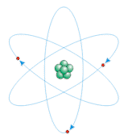 Radon is a naturally occurring radioactive gas that is a product of the uranium decay chain. It is an odorless, colorless, tasteless and inert gas. It can readily move through voids in rocks and soils, and enter homes with other soil gases, through cracks and other openings in building foundations. Because the building is enclosed, the radon gas can accumulate to high concentrations. Long-term exposure to high levels of radon gas increases the risk of developing lung cancer. The CT DPH recommends that all homes be tested for radon gas and to mitigate homes when airborne radon is equal to or greater than 4 pCi/L. Levels between 2 pCi/L and 3.9 pCi/L pose some health risk. Consider reducing radon in your home at levels of 2 pCi/L or greater.
Radon is a naturally occurring radioactive gas that is a product of the uranium decay chain. It is an odorless, colorless, tasteless and inert gas. It can readily move through voids in rocks and soils, and enter homes with other soil gases, through cracks and other openings in building foundations. Because the building is enclosed, the radon gas can accumulate to high concentrations. Long-term exposure to high levels of radon gas increases the risk of developing lung cancer. The CT DPH recommends that all homes be tested for radon gas and to mitigate homes when airborne radon is equal to or greater than 4 pCi/L. Levels between 2 pCi/L and 3.9 pCi/L pose some health risk. Consider reducing radon in your home at levels of 2 pCi/L or greater.
Another way radon can enter a building is through well water. Because radon is not highly soluble in water, it can out-gas to the indoor air environment during household water use (e.g., showering, clothes washing). There is presently no federal or state standard for radon in public drinking water supplies.
A homeowner’s first priority should be to test for radon in the air. If your home is served by a private well, you should also test for radon in the water. If the average of two or more waterborne radon tests is equal to or greater than 5,000 pCi/L, then the homeowner should consider treating the well water. The EPA and DPH recognize that typically, the greater health risks associated with radon are through the inhalation of radon gas and its decay products.
Click on the links below to find out more on radon:
-
Basic Radon Facts (pdf)

